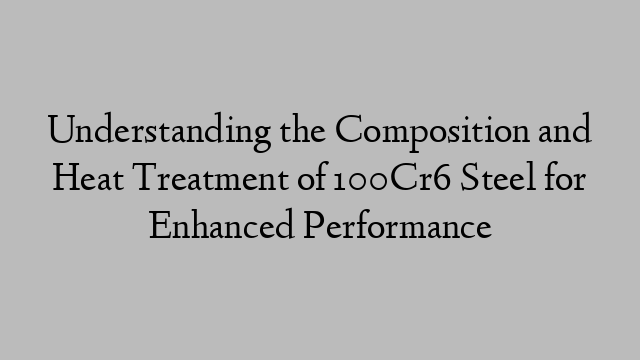Address
304 North Cardinal St.
Dorchester Center, MA 02124
Work Hours
Monday to Friday: 7AM - 7PM
Weekend: 10AM - 5PM
Address
304 North Cardinal St.
Dorchester Center, MA 02124
Work Hours
Monday to Friday: 7AM - 7PM
Weekend: 10AM - 5PM

Understanding the Composition and Heat Treatment of 100Cr6 Steel for Enhanced Performance
1. Specification:
– This document aims to provide a comprehensive understanding of the composition and heat treatment of 100Cr6 steel to achieve improved performance.
– It will cover the mechanical properties and chemical composition of the steel, focusing on factors that contribute to enhanced performance.
2. Mechanical Properties:
– The mechanical properties of 100Cr6 steel are crucial for determining its performance.
– Strength: The steel should exhibit high tensile strength, ensuring its ability to withstand heavy loads without deformation or failure.
– Hardness: 100Cr6 steel should possess excellent hardness to resist wear, abrasion, and deformation under operating conditions.
– Toughness: The steel should exhibit sufficient toughness to withstand impact and shock loading without fracturing.
– Fatigue Resistance: 100Cr6 steel should have high fatigue strength to endure cyclic loading without failure over extended periods.
3. Chemical Composition:
– The chemical composition of 100Cr6 steel greatly influences its properties.
– Carbon (C): The presence of carbon enhances the hardness and strength of the steel while improving its wear resistance.
– Chromium (Cr): The main alloying element in 100Cr6 steel that contributes to its hardenability and corrosion resistance.
– Manganese (Mn): Enhances the hardenability and toughness of the steel.
– Silicon (Si): Improves the steel’s strength and hardness while aiding in deoxidation during production.
– Phosphorus (P) and sulfur (S): These impurities should be minimized as they can negatively affect the steel’s mechanical properties.
4. Heat Treatment:
– Heat treatment plays a significant role in enhancing the mechanical properties of 100Cr6 steel.
– Quenching: The steel is heated to a specific temperature and then rapidly cooled in a quenching medium to achieve high hardness.
– Tempering: This process is performed after quenching to reduce the steel’s brittleness and increase its toughness and ductility.
– Annealing: Heat treatment involving slow cooling to relieve internal stresses, improve machinability, and refine the structure.
– Normalizing: A heat treatment process that enhances the uniformity of the steel’s microstructure and improves its mechanical properties.
In conclusion, understanding the composition and heat treatment of 100Cr6 steel is crucial for achieving enhanced performance. By considering the mechanical properties and chemical composition, manufacturers can optimize the steel’s performance in various applications. Heat treatment processes such as quenching, tempering, annealing, and normalizing further refine the steel’s properties to meet specific requirements.
100Cr6 Steel grade
1698198854